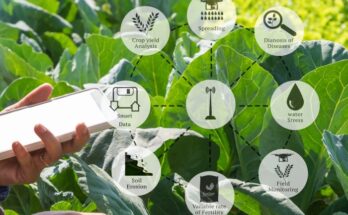In the pursuit of sustainable and regenerative farming practices, technology plays a crucial role. With the ever-increasing challenges posed by climate change, soil degradation, water scarcity, and the need to feed a growing global population, harnessing technology becomes essential.
By integrating innovative technologies into agricultural systems, farmers can enhance efficiency, reduce environmental impact, and foster long-term sustainability. From precision agriculture and remote monitoring to data analytics and artificial intelligence, technology offers a wide range of tools and solutions to support sustainable and regenerative farming.
Precision agriculture
Technology plays a crucial role in precision agriculture, optimising farming practices using data-driven insights. Farmers can utilise satellite imagery, drones, and sensors to monitor soil health, crop growth, and pest infestations. This enables them to make informed decisions about irrigation, fertilisation, and pesticide application, minimising waste and maximising productivity.
You may also like to read: FarmERP to boost cassava plantation AI, ML and deep-tech-enabled platform
Remote sensing technologies, such as satellite imagery and aerial drones, provide farmers with detailed and up-to-date information about their crops. By analysing these images, farmers can identify variations in vegetation health, detect pest or disease outbreaks, and assess overall crop performance. According to a study by Markets and Markets, the precision agriculture market is projected to reach US$12.9 billion by 2025. This indicates a growing recognition of precision farming technologies’ benefits.
Remote monitoring and control
Remote monitoring systems utilise IoT (Internet of Things) sensors and devices to collect real-time data from farms. These sensors measure parameters such as temperature, humidity, soil moisture, nutrient levels, and weather conditions. The data is transmitted wirelessly to a central system, enabling farmers to monitor and analyse information from any location. The IoT and sensor technologies play a significant role in agriculture. It is estimated that the global market for IoT in agriculture will reach US$30.8 billion by 2025, as reported by Allied Market Research.
Data analytics and artificial intelligence (AI)
By analysing historical and real-time data, predictive analytics algorithms can forecast various agricultural outcomes. These algorithms can predict crop yields, disease outbreaks, pest infestations, and even market trends. Farmers can use this information to make informed decisions about planting, resource allocation, and marketing strategies, optimising their operations and improving overall productivity.
You may also like to read: Arya.ag and Bayer form collaboration to promote sustainable agricultural practices
The agricultural industry generates vast amounts of data, and data analytics and artificial intelligence (AI) can unlock valuable insights. According to a McKinsey report, AI has the potential to create US$365 billion in value annually in the agricultural sector by 2030.
Renewable energy integration
Solar panels can be installed on agricultural buildings, such as barns, storage facilities, or greenhouses, to harness sunlight power and generate electricity. This renewable energy source can power farm operations, such as lighting, irrigation systems, machinery, and cooling or heating systems. Solar energy reduces dependence on fossil fuels, lowers energy costs, and mitigates greenhouse gas emissions. The International Renewable Energy Agency (IRENA) reports that the share of renewable energy in total final energy consumption in the agricultural sector is expected to increase by 18 per cent in 2025.
Vertical farming and controlled environment agriculture
Vertical farming utilises surface space efficiently by stacking plants in multiple layers, such as shelves or racks. This allows for higher plant densities and maximises limited land resources, making it suitable for urban areas or areas with limited agricultural land. In controlled environments, such as greenhouses or indoor facilities, vertical farming enables year-round crop production regardless of external weather conditions. By providing ideal growing conditions, including temperature, light, and humidity, crops can be grown continuously, reducing seasonal limitations. Vertical farming is experiencing rapid growth. Grand View Research predicts that the global vertical farming market size will reach US$12.77 billion by 2027. This will be achieved at a compound annual growth rate (CAGR) of 22.8 per cent during the forecast period. Vertical farming enables year-round crop production, efficient resource utilisation, and reduced land footprint, making it a promising solution for sustainable food production in urban areas.
You may also like to read: IITM Pravartak, WayCool Foods join hands to bring regenerative agriculture tech stack to farmers
It is estimated that technology-enabled techniques will drive sector growth in India and the agricultural industry will exceed US$24 billion by 2025. Currently, Asia has the lowest agritech adoption rate of 9 per cent, but the continent is making progress with a 4 per cent adoption rate for sustainable-related technologies. On the bright side, Indian farmers outpace China, the global agricultural leader, in agritech usage.
In conclusion, technology adoption is pivotal to achieving sustainable and regenerative farming practices. Technology offers a multitude of opportunities to address modern agriculture’s complex challenges. By leveraging precision agriculture, remote monitoring and control, data analytics, artificial intelligence, renewable energy integration, vertical farming, and controlled environment agriculture, farmers can optimise resource utilisation, improve productivity, minimise environmental impact, and foster long-term sustainability. These technological advancements enable farmers to make data-driven decisions, monitor and manage crops more effectively, optimise energy usage, reduce waste, and promote biodiversity.
(Darshan Rana is the Chairman & Managing Director of Erisha Agritech. Views expressed in the article are author’s own.)





